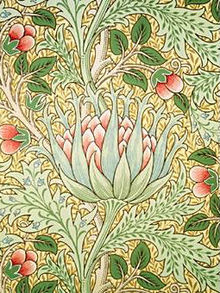England

During the Napoleonic Wars, trade between Europe and Britain evaporated, resulting in the gradual decline of the wallpaper industry in Britain. However, the end of the war saw a massive demand in Europe for British goods which had been inaccessible during the wars, including cheap, colourful wallpaper. The development of steam-powered printing presses in Britain in 1813 allowed manufacturers to mass-produce wallpaper, reducing its price and so making it affordable to working-class people. Wallpaper enjoyed a huge boom in popularity in the nineteenth century, seen as a cheap and very effective way of brightening up cramped and dark rooms in working-class areas. It became almost the norm in most areas of middle-class homes, but remained relatively little used in public buildings and offices, with patterns generally being avoided in such locations. In the latter half of the century Lincrusta and Anaglypta, not strictly wallpapers, became popular competitors, especially below a dado rail. They could be painted and washed, and were a good deal tougher, though also more expensive.
Wallpaper manufacturing firms established in England in the 19th century included Jeffrey & Co.; Shand Kydd Ltd.; Lightbown, Aspinall & Co.; John Line & Sons; Potter & Co.; Arthur Sanderson & Sons; Townshend & Parker. Designers included Owen Jones, William Morris, and Charles Voysey. In particular, many 19th century designs by Morris & Co and other Arts and Crafts designers remain in production.
20th centuryedit
By the early twentieth century, wallpaper had established itself as one of the most popular household items across the Western world. Manufacturers in the USA included Sears; designers included Andy Warhol. Wallpaper has gone in and out of fashion since about 1930, but the overall trend has been for wallpaper-type patterned wallcoverings to lose ground to plain painted walls.
21st centuryedit
In the early 21st century, wallpaper evolved into a lighting feature, enhancing the mood and the ambience through lights and crystals. Meystyle, a London-based company, invented LED-incorporated wallpaper. The development of digital printing allows designers to break the mould and combine new technology and art to bring wallpaper to a new level of popularity.
Historical collectionsedit
Historical examples of wallpaper are preserved by cultural institutions such as the Deutsches Tapetenmuseum (Kassel) in Germany; the Musée des Arts Décoratifs (Paris) and Musée du Papier Peint (Rixheim) in France; the Victoria & Albert in the UK; the Smithsonian's Cooper-Hewitt, Historic New England, Metropolitan Museum of Art, U.S. National Park Service, and Winterthur in the USA. Original designs by William Morris and other English wallpaper companies are held by Walker Greenbank.
Comments
Post a Comment